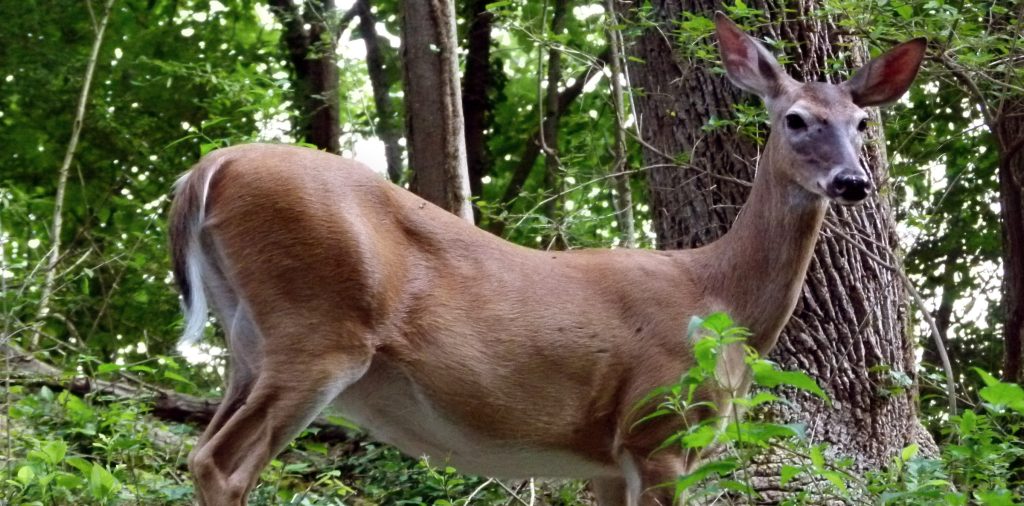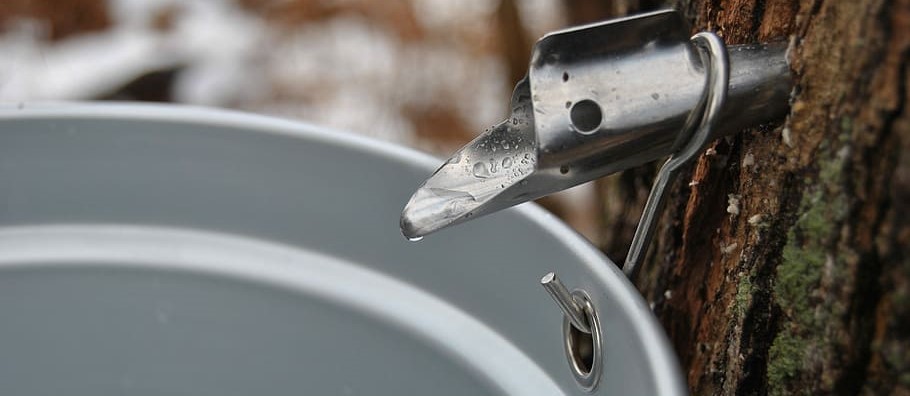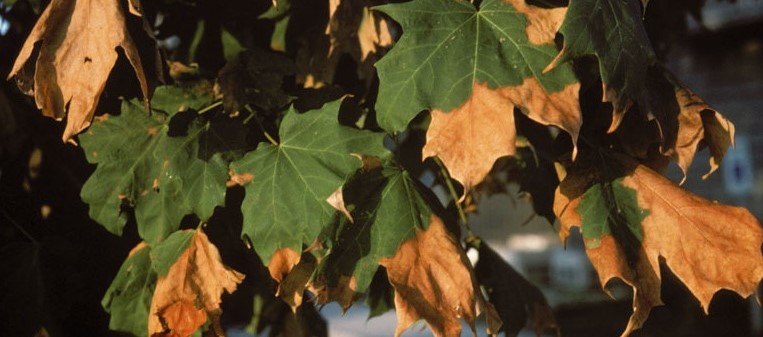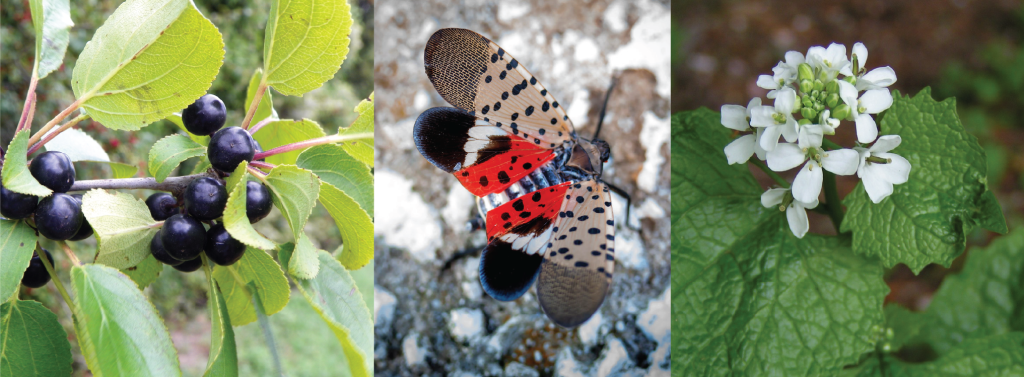Adapting to Changes in Your Sugarbush

Maple syrup producers across the Midwest have noticed changes in their sugarbushes in recent years, such as earlier tapping seasons and the arrival of new invasive and competing plant species and forest pests. We expect these and other changes to continue in the coming decades. By being flexible and adaptable, you can be a good steward of the land, ensuring that your sugarbush thrives for many years into the future.
This sugarbush adaptation guide provides descriptions of current and future environmental challenges along with concrete actions you can take to address them. The challenges are interrelated, so you’ll likely want to focus on several of them together rather than considering each separately.
Think of this as a “menu” of choices. Whether you’re just starting out or have decades of experience, whether you tap a handful of trees or thousands, you can adopt the strategies that make the most sense for your operation. The menu is not comprehensive—your firsthand knowledge of your sugarbush may give you additional adaptation ideas.
Click the (+) to expand each section. You can also download and print a PDF version of the menu and watch a video showcasing how two experienced Wisconsin producers are adapting their operations.
Earlier Tapping Seasons

On average, tapping seasons are starting earlier now than they did a few decades ago. The exact timing, which has always been somewhat variable, is becoming even more unpredictable. These trends will continue.
What you can do:
- Begin watching the forecast earlier in the year and be prepared to tap trees sooner than in the past.
- Consider using a tubing system if you don’t already. It’s more sanitary than buckets and bags, so you can tap earlier without sacrificing late-season sap. Bacterial growth will still cause sap yields to gradually decline by the end of the season, but this loss will be much smaller than it would be with buckets or bags.
- Practice good sanitation habits to get a higher yield. Clean your tubing in the late fall and use new, sterile spouts each year (or use sterilizable stainless steel spouts).
- Once the syrup season begins, run your vacuum system (if you have one) anytime the temperature is above freezing.
Shifts in Sugar Maple Habitat

The range of the sugar maple is expected to gradually move northward during this century. Along the southern edge of the range, tapping sugar maples will likely become impractical in a few decades. Along the northern edge of the range, sugar maples may benefit from the changes and grow in new places. In the central latitudes of the range, sugar maple populations might experience more stress. In northern Wisconsin, Minnesota, and Michigan, sugar maple trees are expected to fare well.
What you can do:
- If you have variations in microclimate on your land, focus on tapping the trees in the cooler areas.
- Decades from now, you may want to focus on tapping the trees on north-facing slopes, where temperatures will rise more slowly than on south-facing slopes.
- Tap red maples in addition to sugar maples. Red maples are expected to flourish in the Midwest in the coming decades. That said, red maples are less valuable for timber than sugar maples, so talk with a forester about the pros and cons of encouraging red maples in your sugarbush.
More Deer Browsing

Deer populations are rising in many parts of the Midwest, which means that deer browsing is hindering forest regeneration. Deer browsing does not threaten mature maple trees, but deer do sometimes damage tubing systems.
What you can do:
- If you want to encourage maple regeneration in an area of your sugarbush, build a deer exclosure to keep out the deer. This will give your saplings a better chance of growing.
- When harvesting timber, create a slash wall out of slash and low-value tree tops to keep out the deer and protect your tubing. Or, rather than building a full slash wall, you could create smaller physical barriers using tree tops or slash to protect young trees.
- If you have a small sugarbush with light to moderate deer browsing, apply a food-safe deer repellent spray—but keep in mind that this will not completely eliminate browsing, and you may need to reapply the repellent once or twice in a season.
- During deer hunting season, encourage people to come hunt in or near your sugarbush.
- Talk with your forester about cost-share programs available from your state or the USDA Natural Resources Conservation Service that can support these practices.
Changes in Soil Composition

Sugar maples require nutrient-rich, moderately moist soils. Earthworms are great for composting and gardening, but they harm Midwestern forests and are not native here. By eating leaf litter and mixing the layers of forest soil, earthworms deplete it of nutrients, which causes tree branches to die from the tips backward (dieback) and makes it harder for maple seeds to start growing. Earthworms also cause the soil to dry out faster and precipitation to run off, exacerbating the effects of drought and extreme rainfall. Additionally, acid rain in recent decades has made the soil more acidic in many forests. Acidic soil and the associated lack of calcium can harm sugar maples by making canopies less vigorous and causing branches and seedlings to die.
What you can do:
- Test your soil composition and acidity—start by contacting your local USDA Natural Resources Conservation Service office. The University of Wisconsin Soil and Forage Lab and the University of Minnesota Soil Testing Laboratory will also analyze soil samples. The results will help you know which tree species are most likely to thrive in your woods.
- If your soil is too acidic or lacks nutrients, consider applying lime or fertilizer to the soil. Maple producers in Canada have applied lime by hand, with a mechanical spreader, or from the air. Some companies offer wheeled mechanical spreaders for sugarbushes that can be pulled by tractors or all-terrain vehicles.
- Before traveling between woods, clean your boots and gear and power-wash the undercarriage of your vehicle to get rid of dirt and debris that could hide earthworm cocoons. When fishing, never discard worms in the environment. And avoid moving soil when transplanting plants. These steps will help slow the spread of earthworms. Once in a forest, earthworms are very difficult to eliminate.
- Look for earthworms in your sugarbush. If you see bare mineral soil with not much leaf litter—a sign that earthworms are abundant—take extra care to avoid spreading dirt and debris to other woods.
- Tap red maples in addition to sugar maples. Compared to sugar maples, red maples can tolerate a wider range of moisture conditions and don’t need as nutrient-rich soil.
Lower Sap Sugar Content

Summers now tend to be hotter than in the past. After a particularly hot summer, the sugar content of the following season’s sap may be lower than usual.
What you can do:
- Take an energy self-assessment to determine how you can make your operation more energy-efficient, which will lessen the financial impact of lower sap sugar content on your operation.
- Use reverse osmosis to increase the sugar concentration of your sap before boiling it.
- Use a pre-heater or a more energy-efficient evaporator to save on fuel costs and boiling time.
- Contact your local USDA Natural Resources Conservation Service office to learn about their Environmental Quality Incentives Program On-Farm Energy Initiative, which might provide you financial assistance to purchase reverse osmosis or upgrade your equipment.
- In consultation with a forester, thin your stand to give your trees space to grow deep, wide crowns. Trees with more vigorous crowns and wider trunks typically yield a higher sap sugar content and sap volume, though you will still see variability from tree to tree and even from day to day.
- Practice good sanitation habits to get a higher yield. Use new, sterile spouts each year (or use sterilizable stainless steel spouts).
- If you use gravity tubing, upgrade to a vacuum tubing system, which can double your sap yield.
- Tap more trees to increase your overall yield of syrup.
- Tap red maples in addition to sugar maples. Red maples with deep, wide crowns can be just as good for sugarmaking as sugar maples. This is true even though red maples sometimes bud out earlier in the spring than sugar maples.
- Make value-added products like maple cream or maple candy in addition to syrup. Product diversification allows you to make more income per unit of sap, which will help your finances in low-yield years.
More Drought and Extreme Rainfall

In the Midwest, annual precipitation is increasing—but it is becoming more concentrated in heavy rainfall events. Coupled with longer summer growing seasons, this means that drought conditions may become more common. Heavy rains tend to run off rather than replenishing soil moisture, and flooding creates imbalances in soil nutrients. All these issues could stress your trees.
What you can do:
- Monitor the health of your woods closely. Healthy trees are more likely to be resilient during droughts and floods.
- Make your woods resilient by encouraging a diversity of species, ages, sizes, and spacing. Eliminating all non-maple trees would leave your sugarbush vulnerable to drought, floods, and other stresses.
- In consultation with a forester, thin your stand to give your trees space to grow deep, wide crowns, which will increase your typical sap sugar content.
- If dead or dying trees are crowding your tapping trees, remove some of the dead or dying trees to give your tapping trees space to grow vigorously. Keep in mind, though, that standing dead trees provide valuable habitat for birds and other wildlife.
- Manage the risk of floods and erosion by following best management practices when building and maintaining roads, trails, and culverts in your sugarbush.
- Learn how to manage flood damage to trees.
- Tap red maples in addition to sugar maples. Compared to sugar maples, red maples can tolerate a wider range of moisture conditions and don’t need as nutrient-rich soil.
More Invasive Species

Changes in weather patterns are making conditions more favorable for invasive species (including plants, animals, and diseases) that might compete with or damage your maple trees. These species are often spread by human activity.
What you can do:
- Learn how to identify and manage invasive species with information from the National Invasive Species Information Center and state-specific resources.
- Learn how to manage or remove buckthorn and garlic mustard, common plants that interfere with maple regeneration.
- Pay attention to nationwide trends on non-local species—some species might cause trouble in other regions before arriving in the Upper Midwest.
- If you notice an invasive species in your woods, take photos, note the date and location, and contact your local Extension agent or state forester to report the sighting.
- Monitor the health of your woods closely. Healthy trees are are more likely to survive attacks by insects and diseases.
- Make your woods resilient by encouraging a diversity of species, ages, sizes, and spacing. Eliminating all non-maple trees would leave your sugarbush vulnerable to invasive species and other stresses.
- Talk with your forester about cost-share programs available from your state or the USDA Natural Resources Conservation Service that can support management of invasive species.
- Before traveling between woods, clean your boots and gear and power-wash the undercarriage of your vehicle to get rid of dirt and debris, which might hide insects and eggs. This will help slow the spread of unwanted species.
Less Winter Snowpack and More Spring Frost

As winters get warmer, you can expect less snowpack on the ground. Without this insulation, trees with shallow roots such as sugar maples could be injured when their roots freeze. Later in the season, early spring warmth may cause trees to break bud before the last frost, which raises the risk of frost damage. Milder winters also shorten the reliable operating season for forest management.
What you can do:
- Monitor the health of your woods closely. Reducing the other stresses on your trees will make them more resilient to damage from freezing temperatures.
- Find a forester in Michigan, Minnesota, or Wisconsin and work with them to create a forest management plan.
- If you notice unhealthy trees in your woods, contact a forest health specialist in Michigan, Minnesota, or Wisconsin to diagnose the causes. Then work with your forester to address the issue.
- When scheduling forest management activities, consider ground conditions (frozen or dry is best) instead of relying only on calendar dates. By doing this and following other best practices for forest management, you can reduce soil damage and erosion.
Indigenous Wisdom

Many Indigenous communities in the Upper Midwest have engaged in sugarmaking since long before the arrival of Europeans. Tribal Nations here recognize plants and animals as teachers and have adapted proactively whenever environmental conditions have changed. Dibaginjigaadeg Anishinaabe Ezhitwaad: A Tribal Climate Adaptation Menu—a tool created by a diverse team of Tribal, intertribal, and non-tribal partners which uses Indigenous culture, language, history, and perspectives to guide climate adaptation for Tribal communities and their partner entities—contains adaptation strategies and approaches related to maple, many of which are similar to those found here.
Stories from Wisconsin Maple Producers
Watch this video to learn how Scott Walter, a sixth-generation maple producer in Viola, and Jeremy Solin, a fourth-generation maple producer in Deerbrook, are adapting their operations in response to environmental changes.
Resources to Learn More
Sugarbush Management
- Cornell Maple Program (2023). Sugarbush Management Notebook. Cornell University College of Agriculture and Life Sciences Department of Natural Resources. https://bpb-us-e1.wpmucdn.com/blogs.cornell.edu/dist/7/5773/files/2023/08/Sugarbush-Management-Notebook-1ed-with-bookmarks__23acknowledgement.pdf
Invasive Species
- Invasive Plants Association of Wisconsin
- Wisconsin Invasive Insect Maps
- Wisconsin First Detector Network
- Michigan State University Extension invasive species guide
- Michigan Invasive Species Program
- University of Minnesota Extension invasive species guide
- Minnesota Department of Natural Resources invasive plants guide
Climate Change Impacts and Adaptation
- Giesting, K. (2020). Maple Syrup. USDA Forest Service Climate Change Resource Center. www.fs.usda.gov/ccrc/topics/maple-syrup
- Northern Institute of Applied Climate Science (2023). Northwoods Regional Forest Vulnerability. Climate Change Response Framework. https://forestadaptation.org/assess/ecosystem-vulnerability/northwoods
- GLIFWC Climate Change Team (2023). Aanji-bimaadiziimagak o’ow aki: Climate Change Vulnerability Assessment Version 2. Great Lakes Indian Fish and Wildlife Commission. https://glifwc.org/ClimateChange/VulnerabilityAssessment.html
- Stults, M., Petersen, S., Bell, J., Baule, W., Nasser, E., Gibbons, E., & Fougerat, M. (2016). Climate Change Vulnerability Assessment and Adaptation Plan: 1854 Ceded Territory Including the Bois Forte, Fond du Lac, and Grand Portage Reservations. https://www.1854treatyauthority.org/images/ClimateAdaptationPlan_Final-July_2016-optimized(1).pdf
- Swanston, Christopher W., et al. (2016). Forest Adaptation Resources: Climate Change Tools and Approaches for Land Managers, 2nd Edition. USDA Forest Service Northern Research Station. https://doi.org/10.2737/NRS-GTR-87-2
- Rapp, J. M., Lutz, D. A., Huish, R. D., Dufour, B., Ahmed, S., Morelli, T. L., & Stinson, K. A. (2019). Finding the sweet spot: Shifting optimal climate for maple syrup production in North America. Forest Ecology and Management, 448, 187–197. https://doi.org/10.1016/j.foreco.2019.05.045
- University of Wisconsin–Madison Extension, USDA Midwest Climate Hub, & USDA Northern Forests Climate Hub (2025). Not So Sweet, but Still Flowing: A climate trends assessment for maple syrup production in the Midwest and Northeast US. https://storymaps.arcgis.com/stories/90af696c7beb4d43a6b1430614fa3eeb
- Wisconsin Initiative on Climate Change Impacts, Forestry Working Group. https://wicci.wisc.edu/forestry-working-group/
- Techtmann, C., Erikson, S., St. Arnold, J., Howk, N., Maloney, J. (2014). Ojibwe Lifeway: Maple Sugaring and Birch Bark Harvesting. Gikinoo’wizhiwe Onji Waaban (Guiding for Tomorrow). http://g-wow.org/en-us/maple_birch/default.aspx
Soil Composition, Fertilization, and Earthworms
- Moore, J.-D., Duchesne, L., Ouimet, R., & Deschênes, M.-L. (2020). Liming improves sap characteristics of sugar maple over the long term. Forest Ecology and Management, 464, 118044. https://doi.org/10.1016/j.foreco.2020.118044
- West, R. R., Lada, R. R., & MacDonald, M. T. (2023). Nutrition and Related Factors Affecting Maple Tree Health and Sap Yield. American Journal of Plant Sciences, 14(2), Article 2. https://doi.org/10.4236/ajps.2023.142011
- Bal, T. L., Storer, A. J., & Jurgensen, M. F. (2018). Evidence of damage from exotic invasive earthworm activity was highly correlated to sugar maple dieback in the Upper Great Lakes region. Biological Invasions, 20(1), 151–164. https://doi.org/10.1007/s10530-017-1523-0
This adaptation menu was researched, written, and designed in 2023 by Scott Hershberger, who was an M.S. student in Life Sciences Communication and Project Assistant for the Extension Maple Syrup Program at the time. Scott is now the Forestry Communications Specialist for the Extension Forestry & Wildlife Program. Funding was made possible by the USDA Agricultural Marketing Service (AMS) Acer Access and Development Grant AM21ACERWI1006. This document’s contents are solely the responsibility of the authors and do not necessarily reflect the official views of the USDA.
Image credits:
Projected sugar maple habitat in 2100: U.S. Forest Service Climate Change Atlas
White-tailed deer: Perkons via Pixabay
Earthworm: Chih-Han Chang, Smithsonian Environmental Research Center, CC BY 2.0
Maple drought stress: Robert L. Anderson, U.S. Forest Service, CC BY 3.0 US
Common buckthorn: anemoneprojectors via Flickr, CC BY-SA 2.0
Spotted lanternfly: WanderingMogwai via Wikimedia Commons, CC BY-SA 4.0
Garlic mustard: sannse via Wikimedia Commons, CC BY-SA 3.0
Buckets on trees: University of Wisconsin–Madison Division of Extension
Last updated October 2025.




